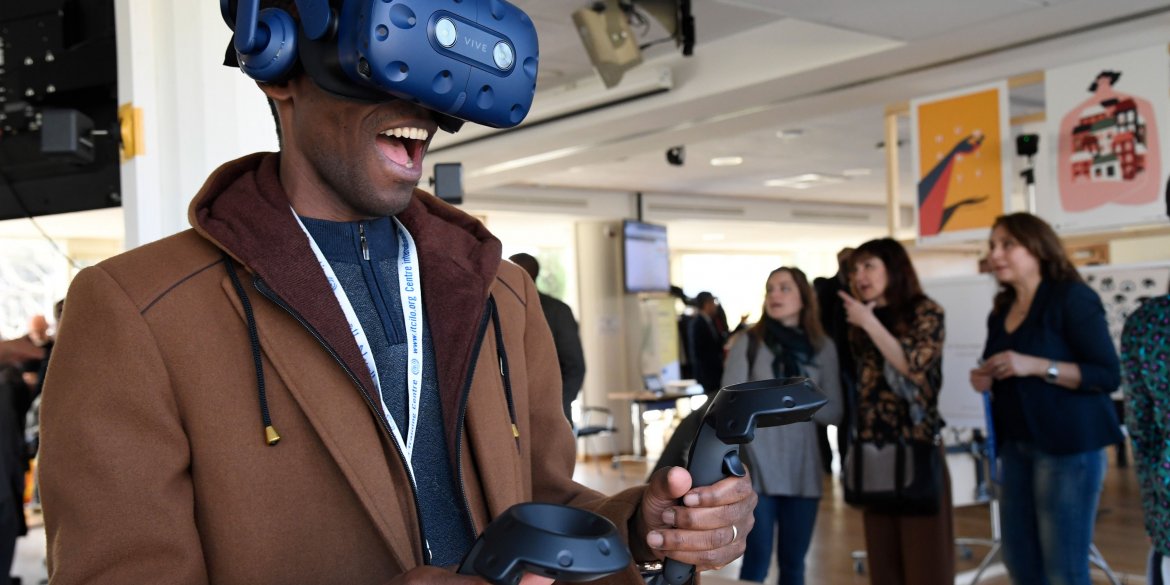3D learning with virtual reality
3D learning with virtual reality
This Innovation Day, the Centre explored how new technology may impact the world of learning and training.
13 February 2020

“Where are you?”
“I'm in a gold mine in Ghana.”
On 11 February, participants in the Centre’s second annual Innovation Day had the chance to step into the classrooms of tomorrow—without leaving the Turin campus.
The ITCILO invited six virtual reality companies to share their ideas about the future of learning and training.
The event, organized like a fair, allowed participants to learn about each technology, ask questions, and try the experience for a few minutes before moving on to the next stand.

Stands included:
-
Gamoteca: Experience mixed reality games that blend the physical world and the digital worlds.
-
EonReality: Skip the abstract thinking in a flipped classroom mixed with immersive content.
-
Bodyswaps: Interact with virtual characters, then swap places and see yourself from their perspective.
-
Arthur: Attend fully digital in-person meetings, without travel and logistics.
-
Mursion: Talk to avatar-based characters boosted by live human interaction.
-
Equalreality: Experience life from the perspective of a person whose gender, race, or ability is different from yours.
-
Dreams of Gold: Follow the stories of three children in Ghana rescued from child labour in gold mines.
“This is a part of our action plan to promote learning innovation in the Centre,” Director of Training Andreas Klemmer welcomed course participants and staff in his opening words.
The idea is to nurture a culture of innovation through exposure to new technology, a physical place to learn, and an opportunity to see what is possible.

Between virtual reality experiences, participants were encouraged to take a ride on Olli, the electric, autonomous bus that will remain on the ITCILO campus for a few more months.
“For me, it was a positive experience,” said Mostafa Mohamed. “It was very well organized and worthwhile. I also got to ride Olli for the first time.”
“I’m probably a bit biased, because I participated in an afternoon workshop with the experts from Bodyswaps,” said Francesca Biasiato. She continued:
It was the most relevant one for our work, because the user can really empathize with people and specific situations. It also stimulates self-reflection through individualized feedback, as well as the opportunity to redo the experience.

Also on display were posters from the international art competition Posterheroes. The exhibition featured the winning artworks of 2019, created around the themes of integration, acceptance, and diversity.
The idea of learning in three dimensions was present throughout the room.
“It was fascinating,” said Giuseppe Zefola. He continued:
I went through three of them. One was an interactive meeting room where, at one point, I was writing on the whiteboard and someone was responding to me, all virtually. I’m very excited about these new horizons opening up.
"I tried the interaction with an avatar guided by artificial intelligence," said Nathalie Mirabile. "It reacted in such a credible way that I forgot it wasn't real! For learning and training, virtual reality allows you to acquire knowledge in a kind of natural way. You can live a situation, repeat it, and rehearse it."

“I see the advantages for the future,” said Hisham Abdel Rahman. “These types of fairs open your eyes because you see the technology applied in hands-on ways and you understand how it could be implemented in training programmes.
It was important to keep an open mind while moving through the physical and augmented spaces, experiencing learning and training in entirely new ways.
Of course, the technology is still evolving. And, for some people, especially those experiencing virtual reality for the first time, the immersive experience can be intense.
“What marked me most was the transition,” said Bertrand Momo. He continued:
You step into a red circle and suddenly you’re in a completely different world. The experience is cool, but there is a friction between the before and after. It’s like lightning.


